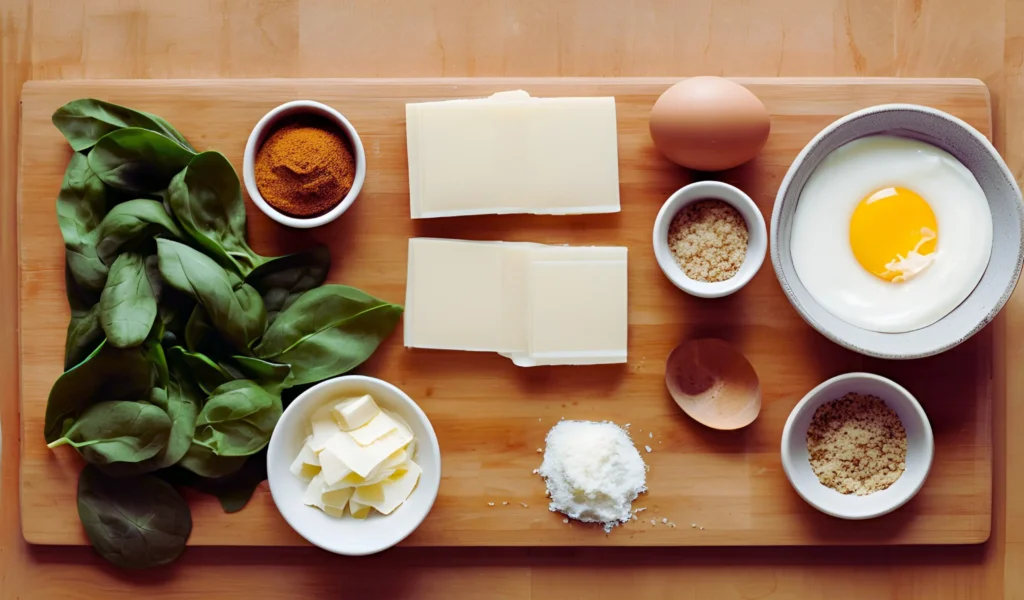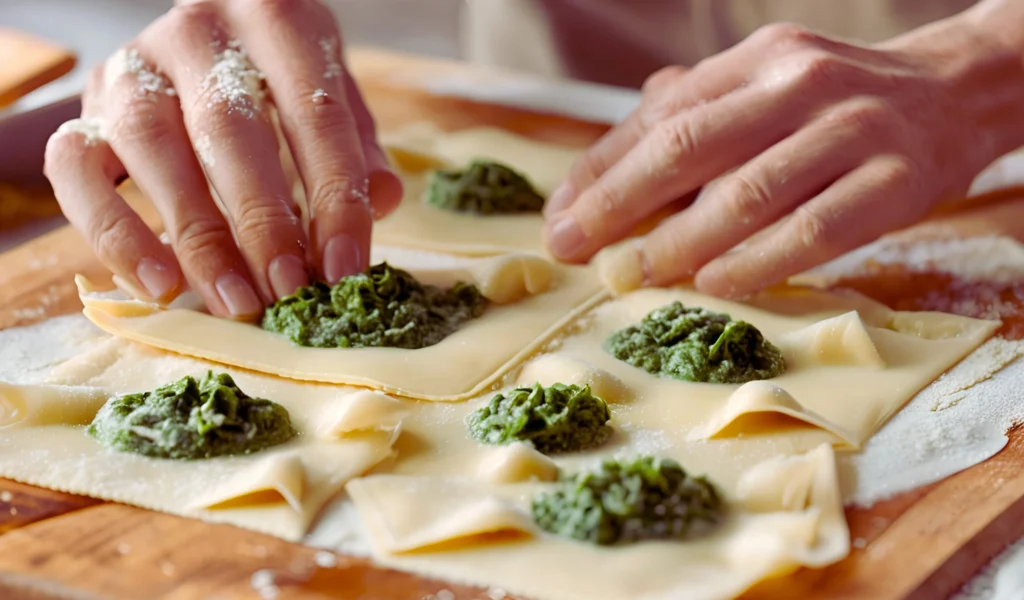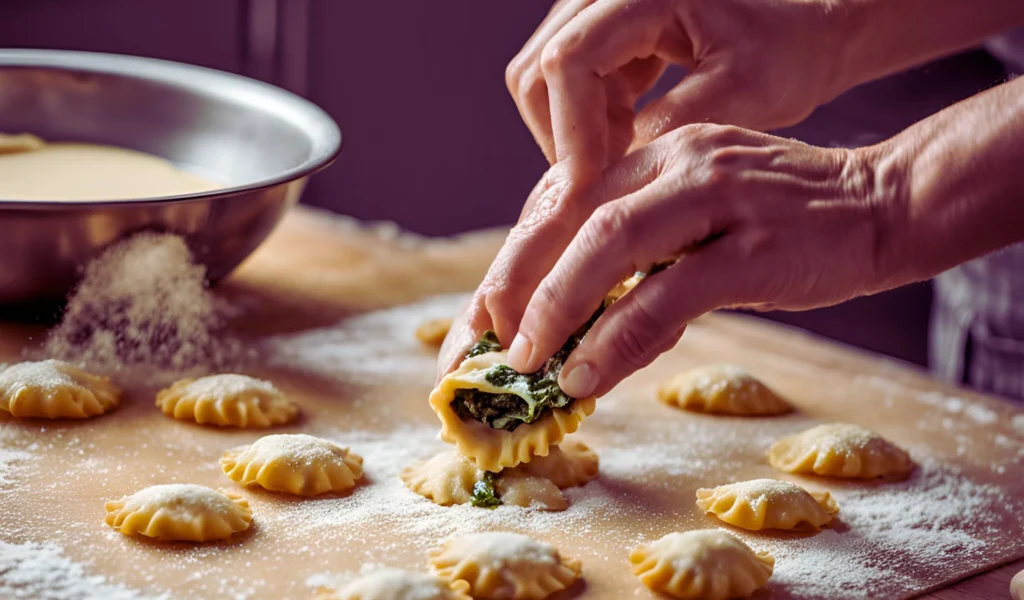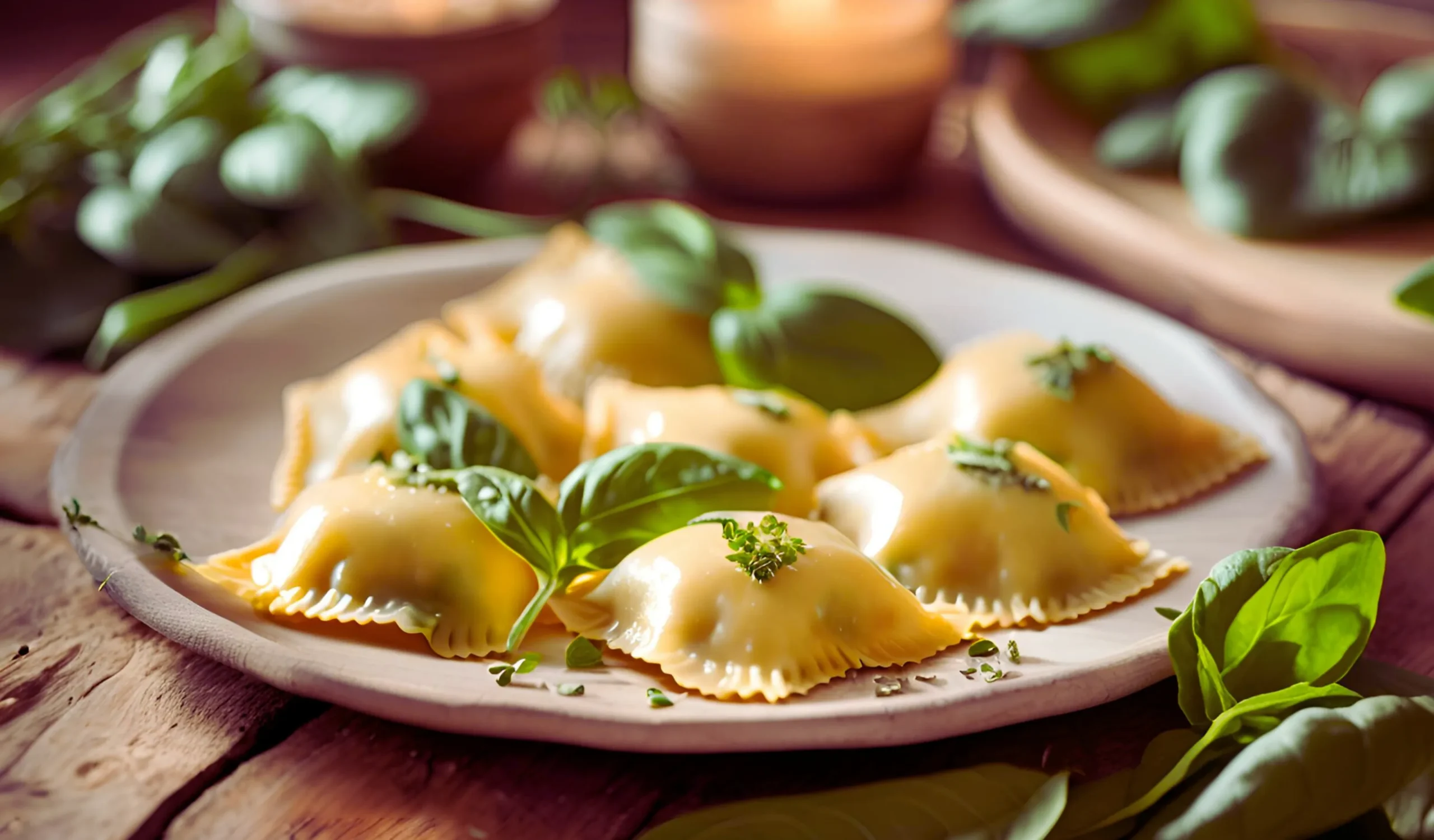Ravioli, the Italian staple, isn’t just about pasta; it’s the delightful filling inside that steals the show! Whether you’re a fan of creamy ricotta, hearty meats, or vibrant vegetables, crafting the perfect ravioli recipe filling elevates your culinary game. This article will guide you through every aspect of ravioli fillings, from classic ingredients to creative variations, with detailed steps, pro tips, and nutritional insights. So, roll up your sleeves, grab your apron, and let’s dive into the art of delicious ravioli!
Part 1: Introduction to Ravioli Recipe Filling
What is Ravioli Recipe Filling?
Ravioli filling is the flavorful core of this beloved Italian dish, transforming humble pasta dough into a gourmet delight. These fillings are versatile, ranging from traditional combinations like ricotta and spinach to creative twists with roasted vegetables or seafood. The goal is a filling that not only complements the dough but also delivers a burst of flavor with every bite.
A Brief History of Ravioli and Its Filling
Ravioli dates back to the 14th century, rooted in Italian culinary tradition. Originally, it was a way to repurpose leftovers by encasing them in pasta dough. Over time, it evolved, with each region of Italy boasting its own unique fillings, such as meat in Emilia-Romagna and ricotta in Tuscany. Today, ravioli symbolizes comfort, creativity, and cultural heritage on plates worldwide.
The Importance of Filling in Ravioli
The filling is the star of the show, offering texture, taste, and variety. While the dough provides structure, the ravioli recipe filling defines the dish’s identity. From creamy cheeses that melt in your mouth to hearty meats that add substance, a well-made filling ensures that your ravioli is unforgettable.
Common Types of Ravioli Fillings
- Cheese-Based Fillings: Ricotta, Parmesan, and mozzarella are classics.
- Meat Fillings: Ground chicken, turkey, or beef mixed with herbs and spices.
- Vegetarian Fillings: Spinach, mushrooms, and pumpkin for a lighter option.
- Seafood Fillings: Crab or shrimp for a touch of luxury.
Crafting ravioli filling is about balancing textures and flavors. Too dry, and it won’t bind; too wet, and the dough may tear. Achieving perfection lies in understanding the ingredients and blending them harmoniously—a skill you’ll soon master!
Part 2: Essential Ingredients for Ravioli Filling

Ingredients for Traditional Ravioli Filling
At the core of a great ravioli filling are its ingredients. Simplicity often wins the day, with traditional recipes highlighting the freshest, most flavorful components. To make a classic cheese-based filling, you’ll need the following:
- Ricotta Cheese: Smooth, creamy, and mild, ricotta serves as the base for most cheese ravioli fillings.
- Parmesan Cheese: Adds a sharp, salty flavor that complements ricotta beautifully.
- Spinach: Lightly sautéed or steamed, spinach introduces a subtle earthiness and vibrant green color.
- Eggs: Bind the filling, ensuring a cohesive texture.
- Nutmeg: A pinch of nutmeg enhances the filling’s sweetness and adds depth.
- Garlic: Minced garlic brings a savory kick that ties the ingredients together.
- Seasoning: A sprinkle of salt and a crack of fresh pepper elevate the flavors.
Optional Ingredients for Customization
If you’re feeling creative, there are endless ways to customize your ravioli filling. Whether you’re looking to add extra protein or craft a vegetarian masterpiece, the possibilities are limitless. Here are a few ideas to inspire you:
- For Meat Lovers:
- Ground Chicken or Turkey: Cooked and seasoned, these proteins provide a lean alternative to beef.
- Prosciutto: Finely chopped, it offers a salty, slightly smoky flavor.
- For Vegetarians:
- Roasted Pumpkin or Butternut Squash: Perfect for a seasonal twist, these ingredients add sweetness and a creamy texture.
- Mushrooms: Sautéed and finely chopped, mushrooms bring an earthy, umami-packed element.
- For Adventurers:
- Truffle Oil: Just a drizzle infuses the filling with luxurious, earthy notes.
- Goat Cheese: Swapping ricotta for goat cheese adds tanginess and creaminess.
Why Quality Matters
The quality of your ingredients significantly impacts the final flavor. Fresh spinach, high-quality cheeses, and free-range eggs make all the difference. While convenience is tempting, it’s worth the extra effort to source premium components for a truly authentic taste.
Substitutions for Dietary Preferences
Cooking for dietary needs doesn’t mean compromising flavor:
- For Vegans: Use plant-based ricotta made from cashews or tofu. Nutritional yeast can replace Parmesan for that cheesy tang.
- For Gluten-Free Diets: Focus on naturally gluten-free fillings like roasted vegetables and ensure your ravioli dough uses gluten-free flour.
Mastering these ingredients is the first step toward creating a filling that bursts with flavor and authenticity.
Part 3: Step-by-Step Ravioli Filling Preparation

Detailed Ravioli Recipe Filling Instructions
Creating the ideal ravioli filling is both an art and a science. It requires careful attention to detail along with a dash of culinary creativity. By following these step-by-step instructions, you’ll craft a flavorful, well-balanced filling that’s sure to impress.
Step 1: Gather and Prepare Ingredients
Begin by gathering all of your ingredients: creamy ricotta, freshly grated Parmesan, vibrant spinach, eggs, minced garlic, a pinch of nutmeg, and seasonings like salt and pepper. If you plan to include extra elements such as meat or roasted vegetables, make sure they’re pre-cooked and fully cooled before mixing them into your filling.
- Wash and chop spinach if using fresh leaves.
- Grate Parmesan cheese for a sharp, fresh flavor.
- Mince garlic finely to ensure it blends seamlessly into the filling.
Step 2: Preparing the Cheese-Based Filling
In a medium mixing bowl, combine the following:
- 1 cup of ricotta cheese
- ½ cup of grated Parmesan
- 1 lightly beaten egg
- ½ teaspoon of nutmeg
- Salt and pepper to taste
Next, sauté your spinach in a touch of olive oil until wilted. Allow it to cool, then chop finely and fold it into the cheese mixture. Mix thoroughly until the filling achieves a creamy yet firm texture.
Step 3: Preparing Meat-Based Filling
For a meat-filled ravioli, cook your ground chicken, turkey, or beef in a skillet with garlic, salt, and pepper until fully browned. Let it cool before mixing with ricotta and Parmesan cheese. Add a pinch of fresh parsley or thyme for added flavor.
Step 4: Ensuring the Right Consistency
The filling should hold its shape when scooped. If it’s too wet, add a tablespoon of breadcrumbs or more Parmesan to absorb the moisture. Conversely, if it feels too dry, stir in a small amount of beaten egg or ricotta.
Step 5: Storing and Handling Ravioli Filling
If not using immediately, transfer the filling into an airtight container and refrigerate for up to two days. For longer storage, freeze the filling in small portions for up to a month. Always bring the filling to room temperature before assembling the ravioli to make handling easier.
Part 4: Popular Ravioli Filling Variations

Classic Ravioli Fillings
For timeless flavor profiles, these classic options never fail to delight:
- Ricotta and Spinach: The quintessential ravioli filling, this simple blend of creamy cheese and leafy greens is a crowd-pleaser.
- Meat and Cheese: A rich combination of seasoned ground meat and cheese satisfies hearty appetites.
Gourmet Ravioli Fillings
Elevate your ravioli game with these sophisticated combinations:
- Lobster Ravioli Filling: Fresh lobster meat, mascarpone cheese, and a hint of lemon zest create a luxurious filling.
- Butternut Squash with Sage: Roasted butternut squash purée paired with sage and nutmeg is perfect for autumn menus.
Vegan and Vegetarian Ravioli Fillings
For plant-based options, try these creative alternatives:
- Mushroom and Caramelized Onion: Sauté mushrooms and onions until golden, then blend with vegan ricotta for a rich, savory filling.
- Roasted Red Pepper and Spinach: Blend roasted red peppers with sautéed spinach for a vibrant, nutrient-packed option.
Part 5: Tips and Tricks for Perfect Ravioli Filling
Achieving the Right Consistency
The perfect ravioli recipe filling should strike a balance between creamy and firm. If the filling is too wet, it can seep through the dough and ruin the ravioli. Here’s how to ensure the right texture:
- Use Fresh Ricotta: Store-bought ricotta can be watery. Drain it using a cheesecloth for a few hours to remove excess liquid.
- Incorporate Breadcrumbs: A small amount of breadcrumbs can help absorb moisture without altering the taste.
- Chill the Filling: Refrigerate the filling for at least 30 minutes before assembling the ravioli to make it easier to handle.
Flavor Enhancements
Want to elevate your ravioli filling? These simple yet effective tips will do the trick:
- Fresh Herbs Over Dried: Opt for fresh parsley, basil, or thyme for a more vibrant flavor.
- Experiment with Cheeses: Swap out Parmesan for Pecorino Romano for a saltier kick or mix in mascarpone for extra creaminess.
- Add Citrus Zest: Lemon or orange zest can brighten up cheese or vegetable fillings, giving them a subtle tang.
Avoiding Common Mistakes
Making ravioli filling isn’t without its pitfalls, but these tips will save you from common errors:
- Don’t Overfill Ravioli: While tempting, too much filling can cause the dough to tear. Use a small spoon to portion the filling evenly.
- Avoid Overcooking Vegetables: Overcooked veggies can make the filling mushy. Lightly sauté or steam them instead.
- Season As You Go: Taste the filling as you mix to ensure the flavors are balanced before adding it to the ravioli.
Pro Tips for Homemade Ravioli Success
- If the filling is crumbly, blend it briefly in a food processor for a smoother texture.
- Always use room-temperature filling when assembling ravioli to avoid condensation making the dough soggy.
- Test a small batch of ravioli before cooking all of them to ensure the filling’s flavor and texture are just right.
Part 6: Pairing Ravioli with Sauces and Sides

Best Sauces for Ravioli Recipe Filling
The sauce you choose can make or break your ravioli dish. A well-paired sauce enhances the flavor of the ravioli recipe filling without overpowering it. Here are some classic options:
- Marinara Sauce: A bright and tangy tomato-based sauce that works wonderfully with cheese and meat fillings. Its acidity balances creamy textures perfectly.
- Brown Butter Sage Sauce: A nutty, aromatic sauce that complements squash or ricotta fillings. The simplicity of butter, sage, and a hint of garlic lets the ravioli shine.
- Alfredo Sauce: Creamy and indulgent, Alfredo pairs beautifully with mushroom or chicken fillings.
- Pesto: A basil pesto sauce adds a fresh, herbaceous kick, especially for vegetarian ravioli like spinach and ricotta.
How to Choose the Right Sauce
- For light fillings like ricotta and spinach, go for delicate sauces like brown butter or olive oil with garlic.
- For heartier fillings, such as meat or mushroom, richer sauces like Alfredo or marinara are ideal.
- Experiment with flavored oils or infused butter for more subtle, gourmet options.
Complementary Side Dishes
While ravioli can easily stand on its own, pairing it with the right sides elevates the meal to a true feast.
- Garlic Bread: Crispy, buttery garlic bread adds texture and soaks up leftover sauce.
- Caesar Salad: Crisp romaine lettuce, creamy dressing, and Parmesan make a refreshing contrast to the ravioli’s richness.
- Roasted Vegetables: Lightly seasoned roasted zucchini, carrots, or asparagus balance out heavier ravioli dishes.
- Sauteed Greens: Spinach or kale sautéed with olive oil and garlic is a nutritious and flavorful pairing.
Plating and Presentation Tips
- Garnish the dish with fresh basil, grated Parmesan, or a drizzle of olive oil for a professional touch.
- Serve ravioli in shallow bowls to highlight the sauce and keep it warm longer.
- Arrange the sides neatly for a visually appealing presentation.
Part 7: Nutritional Information for Ravioli Filling
Understanding Ravioli Recipe Filling Nutrition
Knowing the nutritional value of your ravioli recipe filling helps you enjoy this Italian classic while staying mindful of your dietary needs. While ravioli fillings can vary greatly, here’s a breakdown of the typical nutrients found in a traditional ricotta and spinach filling per 100 grams:
Nutrition Per 100g
| Nutrient | Amount |
|---|---|
| Calories | 180 kcal |
| Protein | 12 g |
| Total Fat | 8 g |
| Saturated Fat | 3 g |
| Carbohydrates | 14 g |
| Fiber | 2 g |
| Sodium | 320 mg |
Nutritional Highlights
- High Protein Content: Thanks to ricotta and Parmesan, ravioli fillings are a good source of protein, especially when combined with lean meat or plant-based alternatives.
- Rich in Vitamins: Spinach adds a healthy dose of Vitamin A, Vitamin K, and iron, supporting overall health.
- Low Fiber: Pair ravioli with fiber-rich sides like roasted vegetables or a salad to round out the meal.
- Moderate Sodium: Parmesan contributes to the sodium content, so use it sparingly if you’re watching your intake.
Adjusting for Dietary Preferences
- Lower-Calorie Options: Replace ricotta with a low-fat cheese alternative and use egg whites instead of whole eggs.
- Vegan Adaptation: Swap out ricotta for a cashew-based cheese and add nutritional yeast for a cheesy flavor.
- High-Protein Additions: Include cooked chicken, turkey, or plant-based protein crumbles.
Portion Awareness
Ravioli is filling and satisfying, so a serving size of 6–8 pieces with a balanced side dish provides a hearty, nutritious meal. If you’re tracking calories, keep in mind that sauces can add significant calories, so opt for lighter options like marinara or olive oil.
Part 8: FAQs About Ravioli Recipe Filling
Frequently Asked Questions
What is the best filling for ravioli?
The best filling for ravioli depends on personal preference. Classic options include ricotta and spinach, which offer a creamy and mild taste, while meat fillings like seasoned ground chicken or beef provide a hearty and satisfying option. For those seeking something unique, gourmet fillings like lobster or roasted butternut squash with sage are crowd-pleasers.
Can I make ravioli filling in advance?
Absolutely! Ravioli filling can be prepared up to two days in advance and stored in an airtight container in the refrigerator. If you’re planning to make it further in advance, freeze the filling in small portions for up to a month. Just let it thaw in the fridge before use.
How do I make vegan ravioli filling?
Creating a vegan ravioli filling is simple and delicious! Replace ricotta with plant-based alternatives like cashew ricotta or tofu blended with nutritional yeast. You can also add roasted vegetables, like mushrooms or pumpkin, to enhance flavor and texture.
Why is my ravioli filling too wet?
A wet filling can result from excess moisture in the ingredients. For example, ricotta often contains a lot of liquid, so it’s essential to drain it using a cheesecloth before mixing. Similarly, vegetables like spinach should be sautéed and pressed to remove water. If the filling is still too wet, adding breadcrumbs can help absorb the moisture.
What are the best herbs for ravioli filling?
Fresh herbs elevate the flavor of ravioli filling. Basil, parsley, thyme, and sage are common choices. For a bit of zest, you can even incorporate a pinch of rosemary or chives. Always use fresh herbs for the best results, as they add a more vibrant flavor than dried ones.
With this final section, your journey into crafting the perfect ravioli filling is complete. By exploring essential ingredients and mastering creative variations, you now have all the tools to create ravioli that’s bursting with flavor and sure to impress. Enjoy your culinary adventure, and happy cooking!
Print
Ravioli Recipe Filling: Step-by-Step Guide to Delicious Fillings
- Total Time: 30 minutes
- Yield: 4 servings 1x
- Diet: Vegetarian
Description
Ravioli is an Italian classic, and the filling is what truly defines the dish. Whether you’re in the mood for creamy ricotta, savory meat, or vibrant vegetables, the right filling can elevate your ravioli experience. This guide provides everything you need to make the perfect ravioli filling, from classic flavors to creative variations. Learn the step-by-step process for preparing fillings, tips for balancing textures, and how to customize them for any dietary preference. Get ready to dive into the world of ravioli and create a flavorful dish everyone will love!
Ingredients
-
Traditional Ricotta and Spinach Filling:
- 1 cup ricotta cheese
- ½ cup grated Parmesan cheese
- 1 lightly beaten egg
- ½ teaspoon nutmeg
- 1 cup fresh spinach (or ½ cup frozen, thawed and drained)
- 1 clove garlic (minced)
- Salt and pepper to taste
-
Optional Additions:
- 1 tablespoon fresh parsley or basil (chopped)
- 1 tablespoon breadcrumbs (if needed to thicken)
- ½ cup mushrooms or roasted pumpkin for added depth or sweetness
Instructions
-
Prepare the Filling:
- For spinach: Sauté the spinach in a little olive oil until wilted. Cool and chop finely.
- Mix ricotta, Parmesan, egg, nutmeg, salt, pepper, garlic, and the cooled spinach in a bowl. Adjust the consistency with breadcrumbs if needed. Taste and adjust seasoning.
-
Assemble the Ravioli:
- Prepare your pasta dough (store-bought or homemade).
- Roll out the dough, spoon filling onto one sheet, cover with another, and seal by pressing out air bubbles. Cut into individual ravioli.
-
Cook the Ravioli:
- Boil the ravioli in salted water for 2-3 minutes until they float.
- Serve with your favorite sauce (marinara, brown butter sage, etc.).
Notes
You can customize this filling with various ingredients like roasted squash, mushrooms, or even meat for a hearty twist. For a vegan filling, substitute ricotta with cashew cheese or tofu, and use nutritional yeast in place of Parmesan.
- Prep Time: 20 minutes
- Cook Time: 5 minutes
- Category: Italian
- Method: Sautéing
- Cuisine: Italian
Nutrition
- Serving Size: 1 ravioli
- Calories: 180 kcal
- Sugar: 2g
- Sodium: 320mg
- Fat: 8g
- Saturated Fat: 3g
- Unsaturated Fat: 4g
- Trans Fat: 0g
- Carbohydrates: 14g
- Fiber: 2g
- Protein: 12g
- Cholesterol: 30mg
Keywords: ravioli, ravioli filling, ricotta spinach ravioli, vegetarian ravioli, homemade ravioli filling

